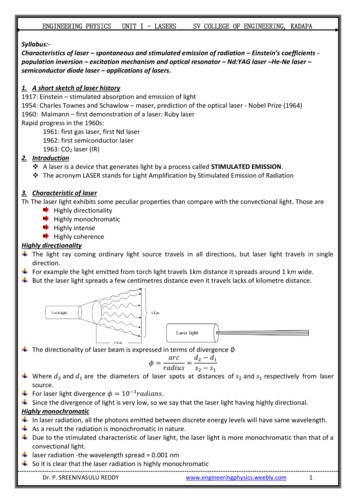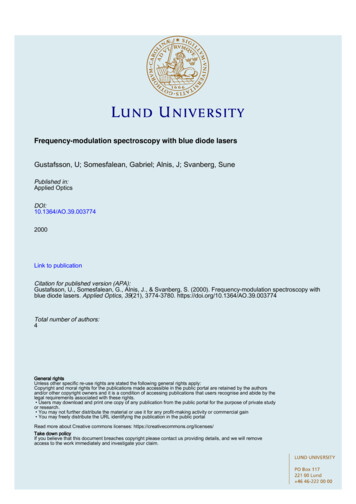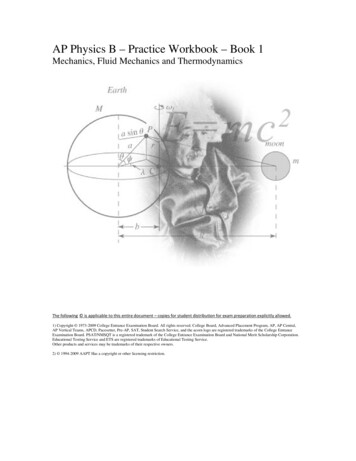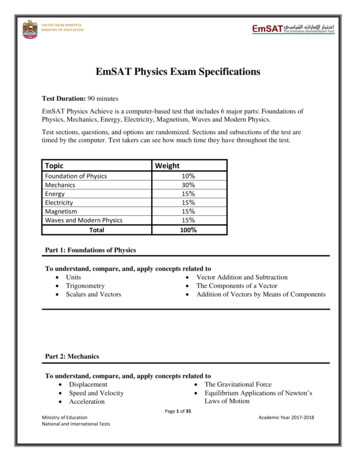
Transcription
ENGINEERING PHYSICSUNIT I - LASERSSV COLLEGE OF ENGINEERING, KADAPASyllabus:Characteristics of laser – spontaneous and stimulated emission of radiation – Einstein’s coefficients population inversion – excitation mechanism and optical resonator – Nd:YAG laser –He-Ne laser –semiconductor diode laser – applications of lasers.1. A short sketch of laser history1917: Einstein – stimulated absorption and emission of light1954: Charles Townes and Schawlow – maser, prediction of the optical laser - Nobel Prize (1964)1960: Maimann – first demonstration of a laser: Ruby laserRapid progress in the 1960s:1961: first gas laser, first Nd laser1962: first semiconductor laser1963: CO2 laser (IR)2. Introduction A laser is a device that generates light by a process called STIMULATED EMISSION. The acronym LASER stands for Light Amplification by Stimulated Emission of Radiation3. Characteristic of laserTh The laser light exhibits some peculiar properties than compare with the convectional light. Those areHighly directionalityHighly monochromaticHighly intenseHighly coherenceHighly directionalityThe light ray coming ordinary light source travels in all directions, but laser light travels in singledirection.For example the light emitted from torch light travels 1km distance it spreads around 1 km wide.But the laser light spreads a few centimetres distance even it travels lacks of kilometre distance.The directionality of laser beam is expressed in terms of divergence 𝑎𝑟𝑐𝑑2 𝑑1𝜙 𝑟𝑎𝑑𝑖𝑢𝑠 𝑠2 𝑠1Where 𝑑2 and 𝑑1 are the diameters of laser spots at distances of 𝑠2 and 𝑠1 respectively from lasersource.For laser light divergence 𝜙 10 3 𝑟𝑎𝑑𝑖𝑎𝑛𝑠.Since the divergence of light is very low, so we say that the laser light having highly directional.Highly monochromaticIn laser radiation, all the photons emitted between discrete energy levels will have same wavelength.As a result the radiation is monochromatic in nature.Due to the stimulated characteristic of laser light, the laser light is more monochromatic than that of aconvectional light.laser radiation -the wavelength spread 0.001 nmSo it is clear that the laser radiation is highly monochromaticDr. P. SREENIVASULU REDDYwww.engineeringphysics.weebly.com1
ENGINEERING PHYSICSUNIT I - LASERSSV COLLEGE OF ENGINEERING, KADAPAHighly intenseLaser light is highly intense than the convectional light.one mill watt He-Ne laser is highly intense than the sun intensitywhen two photons each of amplitude are in phase with other; the resultant amplitude of two photonsis 2a and the intensity is 4a2in laser much number of photons are in phase with each other, the amplitude of the resulting wavebecomes na and hence the intensity of laser is proportional to n2a2So 1mW He-Ne laser is highly intense than the sunHighly coherenceCoherence is the property of the wave being in phase with itself and also with another wave over aperiod of time, and space or distance. There are two types of coherenceTemporal coherenceSpatial coherence.For laser radiation all the emitted photons are in phase, the resultant radiation obeys spatial andtemporal coherence.Temporal coherence (or longitudinal coherence):The predictable correlation of amplitude and phase at one point on the wave train w .r. t anotherpoint on the same wave train, then the wave is said to be temporal coherence.spatially coherence (or transverse coherence).The predictable correlation of amplitude and phase at one point on the wave train w. r .t another pointon a second wave, then the waves are said to be spatially coherence (or transverse coherence).4. Stimulated absorptionLet E1 and E2 are the energies and N1 and N2 are the number of atoms per unit volume of ground andexcited states and ρ(ʋ) be the density of photon density.Suppose, if a photon of energy E2 E1 h interacts with an atom present in the ground state, the atomgets excitation form ground state to excited state by absorbing the photon energy.It is the process of excitation of atom into excited state from ground state by absorbing the incidentphoton.Stimulated absorption rate depends upon the number of atoms available in the lowest energy state as wellas the energy density photons.Stimulated absorption rate N1 𝜌 (ʋ) 𝜌(ʋ) N1 B12 𝜌(ʋ) N1Where B12 is known as Einstein coefficient of stimulated absorptionDr. P. SREENIVASULU REDDYwww.engineeringphysics.weebly.com2
ENGINEERING PHYSICSUNIT I - LASERSSV COLLEGE OF ENGINEERING, KADAPA5. Spontaneous emissionSpontaneous emission was postulated by Bohr.The excited atom does not stay in a long time in the excited state.The lifetime of excited atom in higher state E2 is up to 10-8 seconds.After the life time of the excited atom, gets de-excited into ground by emitting a photon of energyE2 E1 h .It is the process of de-excitation of atom itself into ground state after its life time from excitedstate by emitting a photonSpontaneous emission rate N2 A21 N2Where A21 is known as Einstein coefficient of spontaneous emissionCharacteristics of spontaneous emitted radiation The emitted radiation is poly-monochromatic The emitted radiation is Incoherent The emitted radiation is less intense The emitted radiation has less directionality Example: light from sodium or mercury lamp6. Stimulated emissionStimulated emission was postulated by Einstein.Let, a photon of energy E2 E1 h interacts with the excited atom with in their life time; the atom getsde-excitation into ground state by emitting of additional photon.It is the process of de-excitation of atom into ground state from excited state by interacting withan additional photon within its life time by emitting of an additional photon.Stimulated emission rate depends upon the number of atoms available in the excited state as well as theenergy density of photons.Stimulated emission rate N2 ρ N2 ρ B21 N2 ρWhere B21 is known as Einstein coefficient of stimulated emissionDr. P. SREENIVASULU REDDYwww.engineeringphysics.weebly.com3
ENGINEERING PHYSICSUNIT I - LASERSCharacteristics of stimulated emitted radiation The emitted radiation is monochromatic The emitted radiation is Coherent The emitted radiation is high intense The emitted radiation has high directionality Example: light from laser source7. Spontaneous and Stimulated emissionSV COLLEGE OF ENGINEERING, KADAPASpontaneous emissionStimulated emission1. The spontaneous emission was postulated by 1. The stimulated emission was postulated byBohrEinstein2. Additional photons are not required in 2. Additional photons are required in stimulatedspontaneous emissionemission3. Two photons are emitted in stimulated3. One photon is emitted in spontaneous emissionemission4. The emitted radiation is poly-monochromatic4. The emitted radiation is monochromatic5.6.7.8.The emitted radiation is IncoherentThe emitted radiation is less intenseThe emitted radiation have less directionalityExample: : light from sodium or mercury lamp5.6.7.8.The emitted radiation is CoherentThe emitted radiation is high intenseThe emitted radiation have high directionalityExample: light from laser source8. Einstein coefficientsIt establishes the relation between the three coefficients i.e. stimulated absorption, spontaneousemission, and stimulated emission coefficientsLet N1 be the number of atoms per unit volume with energy E1 and N 2 be the number of atoms per unitvolume with energy E2 and be the the density of photons. When the photons interact with groundlevel atoms, both upward (absorption) and downward (emission) transition occurs.At the equilibrium the upward transitions must be equal downward transitions.Upward transitionStimulated absorption rate depends upon the number of atoms available in the lowest energy state as wellas the energy density photons.Stimulated absorption rate N1 B12 N1 Where B12 is the Einstein coefficient of stimulated absorption.Downward transitionThe spontaneous emission rate depends up on the number of atoms present in the excited state.Spontaneous emission rate N 2 A21N 2Where A21 is the Einstein coefficient of spontaneous emission.Stimulated emission rate depends upon the number of atoms available in the excited state as well as theenergy density of photons.Stimulated emission rate N 2 Dr. P. SREENIVASULU REDDYwww.engineeringphysics.weebly.com4
ENGINEERING PHYSICSUNIT I - LASERS B21N2 SV COLLEGE OF ENGINEERING, KADAPAWhere B21 is the Einstein coefficient of stimulated emission.If the system is in equilibrium the upward transitions must be equal downward transitions.𝐵12 𝑁1 𝜌(𝜐) 𝐴21 𝑁2 𝐵21 𝑁2 𝜌(𝜐)𝐵12 𝑁1 𝜌(𝜐) 𝐵21 𝑁2 𝜌(𝜐) 𝐴21 𝑁2𝜌(𝜐)(𝐵12 𝑁1 𝐵21 𝑁2 ) 𝐴21 𝑁2𝐴21 𝑁2𝜌(𝜐) (𝐵12 𝑁1 𝐵21 𝑁2 )Divide with 𝐵21 𝑁2 in numerator and denominator in right side of the above equation𝜌(𝜐) 𝜌(𝜐) 𝐴21 𝑁2 𝐵 𝑁21 2(𝐵12 𝑁1 𝐵21 𝑁2 ) 𝐵 𝑁21 2𝐴21 𝑁2 𝐵 𝑁21 2(𝐵12 𝑁1 𝐵21 𝑁2 ) 𝐵 𝑁21 2𝐴21 𝐵21 𝐵12𝑁1𝐵21 𝑁2 𝐵12 𝑒𝐵21 1(1)𝐴21 𝐵21(2)(𝐸2 𝐸1 ) 𝐾𝑇 1From Maxwell Boltzmann distribution law(𝐸2 𝐸1 ) 𝑁1𝐾𝑇 𝑒𝑁2From Planck’s law, the radiation density8𝜋ℎ𝜐3 /𝐶 3𝜌(𝜐) 𝑒 (𝐸2 𝐸1)/𝑘𝑇 1Comparing the two equations (2) and (3)A21 8 h 3B12and 1B21C3(3)B21The above relations referred to as Einstein coefficients relations.From the above equation for non degenerate energy levels the stimulated emission rate is equal to thestimulated absorption rate at the equilibrium condition.B21 B129. Population inversionLet us consider two level energy system of energies E1 and E2 as shown in figure. Let N1 and N2 bethe populations of energy levels E1 and E2. The number of atoms present in an energy level is known aspopulation of that energy level. At ordinary conditions, i.e., the population in the ground or lower state isalways greater than the population in the excited or higher states. The stage of making, population ofhigher energy level is greater than the population of lower energy level is called population inversion.According to Boltzmann’s distribution the population of an energy level 𝐸𝑖 at temperature T is given by 𝑬𝒊𝑵𝒊 𝑵𝟎 𝒆( 𝑲𝑻 )Where 𝑁0 𝑖𝑠 the population of the lower level or ground state and k is is the Boltzmann’s constant.The number of atoms present in the excited state (N2) is greater than the number of atomspresent in the ground state (N1) is called population inversion.Dr. P. SREENIVASULU REDDYwww.engineeringphysics.weebly.com5
ENGINEERING PHYSICSUNIT I - LASERSSV COLLEGE OF ENGINEERING, KADAPAThe process of raising the particles from ground state to excited state to achieve populationinversion is called pumping. (Or the process of achieving of population inversion is called pumping)To understand the concept of laser emission (stimulated emission) let us consider a three energylevel system with energies E1, E2 and E3 of populations, N1, N2 and N3.At normal conditions, E1, E2 E3 andN1, N2 N3. In the ground state the life time of atom is more and the life time of atom in the excited stateis 10-8sec. But in the intermediate state the atom has more life time. So it is called metastable state.When a suitable energy is supplied to the system, atoms get excited into E3. After their lifetime theatoms are transit into E2. Due to more lifetime of an atom in state E2, the atoms stay for longer time thancompare with the state E3. Due to the accumulation of atoms instate E2, the population inversion isestablished in between the E1 and E2 states.10. Types of lasersOn the basis of active medium used in the laser systems, lasers are classified into several typesI. Solid lasers: Ruby laser, Nd;YAG laser, Nd;GlassII. Liquid lasers: Europium Chelate laser, SeOCl2III. Gas lasers: CO2, He-Ne, Argon-Ion LaserIV. Dye lasers: Rhodamine 6GV. Semiconductor lasers: InP, GaAs.VI. Chemical lasers: HF, DF.11. Construction and components of laserGenerally, every laser system consists of three components. They area. Energy sourceb. Active mediumc. Optical cavity or resonatorEnergy sourceTo get laser emission, first we must have population inversion in the active medium.The energy source supplies the energy to the active medium.By absorbing that energy, the atoms or molecules or ions can be excited into higher levels.As a result we get population inversion in the active medium.Dr. P. SREENIVASULU REDDYwww.engineeringphysics.weebly.com6
ENGINEERING PHYSICSUNIT I - LASERSSV COLLEGE OF ENGINEERING, KADAPAActive mediumDefinition: - In which medium we are creating population inversion to get stimulated emission ofradiation is called active medium.After receiving the energy from the source, the atoms or molecules or ions get excites into higherenergy levels.While de-excitation to lower energy level, the emitted photons starts stimulated emission whichresults laser emission.Depending upon the active medium the lasers or classified as solid state, liquid state, gaseous stateand semiconductor lasers.Optical cavity or resonatorThe active medium is enclosed between a fully reflective mirror and partially reflective mirror. Thesemirrors constitute the optical cavity or resonator.The reflectors enhance the stimulated emission process by reflecting the photons into the activemedium.As a result we get high-intensity monochromatic and coherent laser light through the partiallyreflecting portion of the mirror.12. Excitation mechanismsExcitation of atom can be done by number of ways. The most commonly used excitation methods areOptical pumpingElectrical discharge pumpingChemical pumpingInjection current pumpingOptical pumpingOptical pumping is a process in which light is used to raise the atoms from a lower energy level tohigher level to create population inversion.Optical pumping is used in solid laser.The solid materials have very broad absorption band, so sufficient amount of energy is absorbed fromthe emission band of flash lamp to create population inversion.Xenon flash tubes are used for optical pumping.Examples: - Ruby laser, Nd:YAG Laser (Neodymium: Yttrium Aluminum Garnet), Nd: Glass LaserElectrical discharge pumpingIn electric discharge pumping, atoms are excited into excited sate by collisions with fast movingelectrons in electric discharge tube.Electrical discharge pumping is used in gas lasers.Since gas lasers have very narrow absorption band, so optical pumping is not suitable for gas lasers.Examples:- He-Ne laser, CO2 laser, argon-ion laser, etcChemical pumpingIn this method the chemical energy released during the chemical process, that energy will excite theatoms to higher level and create population inversion.Whenever hydrogen reacts with fluorine, it liberates lot of heat energy. By utilizing this heat energy theatoms excites into higher states and create population inversion.Examples:-HF and DF lasers.Injection current pumpingThis pumping mechanism is used in semiconductor lasers.In semiconductor lasers, by passing high currents across the junction, the population inversion willcreate.In semiconductors lasers the population inversion always creates among majority and minority chargecarriers.Examples:- InP and GaAs lasers13. He-Ne laserDr. P. SREENIVASULU REDDYwww.engineeringphysics.weebly.com7
ENGINEERING PHYSICSUNIT I - LASERSSV COLLEGE OF ENGINEERING, KADAPAIn 1960, the first laser device was developed by T.H. Mainmann.Ruby laser is a pulse laser, even it have high intense output.For continuous laser beam gas lasers are used.The output power of the gas laser is generally in few milli watts.The first He-Ne gas laser was fabricated by Ali Javan and others.ConstructionIn He-Ne gas laser, the He and Ne gases are taken in the ratio 10:1 in the discharge tube.Two reflecting mirrors are fixed on either ends of the discharge tube, in that, one is partially reflectingand the other is fully reflecting which serve as optical cavity or resonator.In He-Ne laser 80 cm length and 1 cm diameter discharge tube is generally used.The out power of these lasers depends on the length of the discharge tube and pressure of the gasmixture.When the two windows are set at Brewster’s angle, the output laser is linearly polarized.WorkingWhen the electric discharge (fast moving electrons) is passing through the gas mixture, the electronscollide with the He gas atoms excites into higher levels F2 and F3 form F1 by absorbing the electronsenergy.In He atoms higher levels F2 and F3, the life time of He atoms is more.Since F2 and F3 states are acting as metastable states, so the He atom cannot return to ground groundlevel through spontaneous emission.So there is a maximum possibility of energy transfer between He and Ne atoms through atomiccollisions.When He atoms present in the levels F2 and F3 collide with Ne atoms present ground state E1, the Neatoms gets excitation into higher levels E4 andE6.Dr. P. SREENIVASULU REDDYwww.engineeringphysics.weebly.com8
ENGINEERING PHYSICSUNIT I - LASERSSV COLLEGE OF ENGINEERING, KADAPADue to the continuous excitation of Ne atoms, we can achieve the population inversion between thehigher levels E4 (E6) and lower levels E3 (E5).The various transitions E6 E5 , E4 E3 and E6 E3 leads to the emission of wavelengths3.39 m, 1.15 m and 6328 A0 .The first two corresponding to the infrared region while the last wavelength is corresponding to thevisible region.The Ne atoms present in the E3 level are de-excited into E2 level, by spontaneously emitting a photonof around wavelength 6000A0.When a narrow discharge tube is used, the Ne atoms present in the level E 2 collide with the walls ofthe tube and get de-excited to ground level E1.The excitation and de-excitation of He and Ne atoms is a continuous process and thus it givescontinuous laser radiations.Advantages:He-Ne laser emits continuous laser radiation.Due to the setting of end windows at Brewster’s angle, the output laser is linearly polarized.Gas lasers are more monochromatic and directional when compared with the solid state laser.14. Semiconductor diode laserLaser diode is a specially fabricated p-n junction device that emits coherent radiation.It is operated at forward biased condition.Direct band gap semiconductors are preferred in the fabrication of semiconductor laser diodesbecause they emit energy in terms of light when an electron and hole recombination takes place.Compound semi-conductors like GaAs and InP are examples for direct band gap semiconductorsConstructionIn this laser system, the active medium is a p-n junction diode made from crystalline gallium arsenide.The p-region and n-region in the diode are obtained by heavily doping with germanium and telluriumrespectively in GaAs.The thickness of the p-n junction is very narrow so that the emitted radiation has large divergence andpoor coherence.At the junction two sides are roughed to avoid laser emission and the remaining two faces one ispartially polished and the other is fully polished.The laser emission takes place from the partially polished face.To provide bias two metal contacts are provided in the top and bottom of the diode as shown in figure.Dr. P. SREENIVASULU REDDYwww.engineeringphysics.weebly.com9
ENGINEERING PHYSICSUNIT I - LASERSSV COLLEGE OF ENGINEERING, KADAPAWorkingThe semiconductor laser device is always operated in forward bias condition.Electrons and the holes are the minority charge carriers in n-region and p-region semiconductors.When a huge current (104 Amp/mm2) is passing through the p-n junction, p-region is positively biased,holes are injected into n-region from p-region and n-region is negatively biased electrons are injectedinto p-region from n-region as shown in figure.The continuous injection of charge carriers creates the population inversion of minority carriers in nand p sides’ respectively.The electrons and holes recombine and release of light energy takes place in or near the junction asshown in figure.The emitted photons increase the rate of recombination of injected electrons from the n-region andholes in p-region by inducing more recombinations.𝐶From Planck’s law 𝐸𝑔 ℎ𝜐 ℎ 𝜆ℎ𝐶 6.63 10 34 3 108𝜆 8874𝐴0𝐸𝑔1.4 1.6 10 19In case of GaAs homo-junction which has an energy gap of 1.44eV gives a laser beam of wave lengtharound 8874A0.The wave length of emitted radiation depends up on the concentration of donor and acceptor atoms inGaAs.The efficiency of the laser emission is increases when we cool the GaAs diode.15. Nd:YAG [Neodymium-Yttrium Aluminium Garnet] laserNd: YAG laser is a solid state four level laser.Nd stands for Neodymium and YAG for Yttrium Aluminium Garnet (Y 3Al5O12).Nd-YAG rod, Nd3 ions are act as active medium.It is developed by H.M Marcos and L.G Van Vitert in 1964.ConstructionAn Nd-YAG laser consists of a crystalline cylindrical Nd-YAG rod [Y3Al5012].Nd: YAG crystalline material is formed by 1% Y3 replaced by the triply ionised neodymium (Nd3 )The dimensions of the Nd: YAG rod is 10 cm length and 6-9 cm diameter.One end of the Nd-YAG rod is fully silvered and the other end is partially silvered which serve as opticalcavity or resonator.The Nd-YAG rod surrounded by elliptical glass cavity which in turn is enclosed by xenon flash lamp filledwith xenon gas s shown in fig1.Dr. P. SREENIVASULU REDDYwww.engineeringphysics.weebly.com10
ENGINEERING PHYSICSUNIT I - LASERSSV COLLEGE OF ENGINEERING, KADAPAWorkingWhen xenon flash lamp is switched on, it emits thousand joules of light energy is discharged in afew milliseconds. A part of this light energy will be flashes on the Nd-YAG rod.Then the Nd3 are excited to higher energy states E4 from ground state E1 by absorbing the light7200 A0 to 8000 A0 wavelength.1.064 μmThe excited Nd3 ions then make a transition from these energy levels.In the excited state E4 the life time of Nd3 ions are very small so it de-excites into E3 state throughnon-radioactive transition.In E3 state the life time of Nd3 ions is large, so it will act as Meta stable state.In Meta stable state, the Nd3 ions remain for longer duration of the order 10-3 second, so populationinversion takes place between Meta stable E3 and E2 state.The Nd3 Ions are de-excited into ground E1 state through fast decay.Hence, pulsed form of laser beam of wavelength 1.064 µm is emitted during transition from E2to E1.Applications of Nd-YAG LaserThese lasers are widely used for cutting, drilling, welding in the industrial products.It is used in long haul communication systems.It is also used in the endoscopic applicationsDr. P. SREENIVASULU REDDYwww.engineeringphysics.weebly.com11
ENGINEERING PHYSICS16. Applications of lasersUNIT I - LASERSSV COLLEGE OF ENGINEERING, KADAPADue to high intensity, high monocromacity and high directionality of lasers, they are widely used in various fields like1. communication2. computers3. chemistry4. photography5. industry6. medicine7. military8. scientific research1. communicationIn case of optical communication semiconductors laser diodes are used as optical sources and its bandwidth is (1014Hz) is very high compared to the radio and microwave communications. More channels can be sent simultaneously Signal cannot be tapped As the band width is large, more data can be sent. A laser is highly directional and less divergence, hence it has greater potential use in space crafts andsubmarines.2. Computers In LAN (local area network), data can be transferred from memory storage of one computer to othercomputer using laser for short time. Lasers are used in CD-ROMS during recording and reading the data.3. Chemistry Lasers are used in molecular structure identification Lasers are also used to accelerate some chemical reactions. Using lasers, new chemical compounds can be created by breaking bonds between atoms are molecules.4. Photography Lasers are also used in the construction of holograms. Lasers can be used to get 3-D lens less photography.5. Industry Lasers can be used to blast holes in diamonds and hard steel Lasers are also used as a source of intense heat Lasers are used to drill holes in ceramics. Lasers are used to cut glass and quartz. Lasers are used for heat treatment in the tooling and automotive industry. Lasers are used in electronic industry in trimming the components of ICS. High power lasers are used to weld or melt any material. Lasers are also used to cut teeth in saws and test the quality of fabric.6. Medicine Lasers are used for cataract removal. Lasers are used for eye lens curvature corrections. Lasers are used in bloodless surgery. Lasers are used in cancer diagnosis and therapy. Lasers are used in destroying kidney stones and gallstones. Argon and carbon dioxide lasers are used in the treat men of liver and lungs. Lasers used in endoscopy to scan the inner parts of the stomach. Lasers used in the elimination of moles and tumours which are developing in the skin tissue. Lasers are used in plastic surgery. Lasers are used in the treatment of mouth diseases.7. Military Lasers can be used as a war weapon. High energy lasers are used to destroy the enemy air-crofts and missiles. Lasers can be used in the detection and ranging likes RADAR.Dr. P. SREENIVASULU REDDYwww.engineeringphysics.weebly.com12
ENGINEERING PHYSICSUNIT I - LASERSSV COLLEGE OF ENGINEERING, KADAPA8. Scientific field Lasers are used for isotope preparation. Lasers are employed to create plasma. Lasers are used in air pollution, to estimate the size of the dust particles. Lasers are used in the field of 3D-photography Lasers used in Recording and reconstruction of hologram. Lasers used to produce certain chemical reactions. Lasers are used in Raman spectroscopy to identify the structure of the molecule. Lasers are used in the Michelson- Morley experiment.Dr. P. SREENIVASULU REDDYwww.engineeringphysics.weebly.com13
ENGINEERING PHYSICS UNIT I - LASERS SV COLLEGE OF ENGINEERING, KADAPA Dr. P. SREENIVASULU REDDY www.engineeringphysics.weebly.com 5 B21 2 UXN Where B21 is the Einstein coefficient of stimulated emission. If the system is in equilibrium the u










